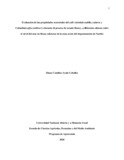Please use this identifier to cite or link to this item:
https://repository.unad.edu.co/handle/10596/36886Full metadata record
| DC Field | Value | Language |
|---|---|---|
| dc.contributor.advisor | Yepes Davalos, Rocio del carmen | - |
| dc.coverage.spatial | cead_-_pasto | spa |
| dc.creator | Ayala Ceballos, Diana Catalina | - |
| dc.date.accessioned | 2020-10-21T01:47:07Z | - |
| dc.date.available | 2020-10-21T01:47:07Z | - |
| dc.date.created | 2020-10-19 | - |
| dc.identifier.uri | https://repository.unad.edu.co/handle/10596/36886 | - |
| dc.description.abstract | La sustentabilidad de los procesos de producción de café, la calidad del grano y la economía campesina del pequeño caficultor son procesos que requieren de tecnologías apropiadas que eviten daño ambiental como el gasto de agua excesivo en el lavado de café. Esta fue la razón que motivo el estudio exploratorio realizado en tres fincas cafeteras del Norte de Nariño, donde se tomaron muestras de café en cereza para someterlas a beneficio convencional y con método Honey, con el café verde obtenido por los dos métodos se comparó la calidad sensorial realizando pruebas de taza. Encontrándose diferencias estadística mente significativas cuanto a la fragancia –aroma, mejor sabor residual, acidez, cuerpo, dulzura, balance, que son mejoradas por el método Honey. Para características como el sabor, uniformidad y limpieza, no se encontraron diferencias estadística mente significativas entre los tratamientos. El puntaje del catador y la impresión global, permiten ver diferencias estadística mente significativas entre los tratamientos, lo que indica que las muestras de café verde obtenidas por vía Honey, presentaron mayor puntaje de catacion. Al promediar los datos correspondientes al mejoramiento de atributos mediante el método Honey, se obtiene 2.1 puntos, que corresponden al mejoramiento de atributos mediante método Honey. Con la aplicación del método Honey, se obtuvo una reducción del 99% de uso del agua, sin llegar a ser cero el gasto de agua con el método Honey, puesto que la gran mayoría de caficultores despulpan con agua. La implementación del método Honey, en las tres fincas adecuando la infraestructura de beneficio existente requiere unos costos de 505.000 pesos colombianos. El costo en ventas por kilo de cps tuvo en un incremento mínimo de 1203 pesos colombianos y un incremento máximo de 9800 pesos colombianos. Se encontró que en el café vía Honey, se acentúan las características sensoriales de los granos de café, destacando el dulzor,taza limpia, suave, con notas cítricas, frutales, en comparación con los resultados del Convencional, donde la taza presentó amargo, pesado, astringencia concluyendo que el beneficio Honey es una opción para el pequeño productor cafetero del norte de Nariño, con grandes benéficos ambientales y mejores ingresos. | spa |
| dc.format | ||
| dc.title | Evaluación de las propiedades sensoriales del Café variedad Castillo, caturra y Colombia(Coffea arábica l.) durante el proceso de secado Honey, a diferentes alturas sobre el nivel del mar en fincas cafeteras de la zona norte del departamento de Nariño. | |
| dc.type | Proyecto de investigación | |
| dc.subject.keywords | Café, Calidad, Producción, Agua, Humedad | spa |
| dc.description.abstractenglish | The sustainability of coffee production processes, grain quality and the peasant economy of the small coffee grower are processes that require appropriate technologies that prevent environmental damage such as excessive water expenditure in coffee washing. This was the reason for the exploratory study carried out on three coffee farms in North Nariño, where samples of cherry coffee were taken for conventional benefit and honey, with green coffee obtained by the two methods the sensory quality was compared by performing cup tests. Statistically significant differences in fragrance – aroma, better residual flavor, acidity, body, sweetness, balance, which are improved by the Honey method. For characteristics such as taste, uniformity and cleanliness, no statistically significant differences were found between treatments. The taster's score and overall impression show statistically significant differences between treatments, indicating that green coffee samples obtained via Honey had higher tasting scores. By averaging the data for improving attributes using the Honey method, you get 2.1 points, which correspond to the improvement of attributes using the Honey method. With the application of the Honey method, a 99% reduction in water use was achieved, without getting zero the water expenditure with the Honey method, since the vast majority of coffee growers snever with water. The implementation of the Honey method, on the three farms adapting the existing profit infrastructure requires costs of 505,000 Colombian pesos. The cost in sales per kilo of cps had a minimum increase of 1203 Colombian pesos and a maximum increase of 9800 Colombian pesos. It was found that in coffee via Honey, the sensory characteristics of coffee beans are accentuated, highlighting the sweetness, clean, soft cup, with citrus, fruity notes, compared to the results of the Conventional, where the cup presented bitter, heavy, astringency concluding that the Honey benefit is an option for the small coffee producer in northern Nariño, with large environmental benefits and better incomes. | spa |
| Appears in Collections: | Agronomía | |
Files in This Item:
| File | Description | Size | Format | |
|---|---|---|---|---|
| Cafehoney .pdf | 3.77 MB | Adobe PDF |  View/Open |
Items in DSpace are protected by copyright, with all rights reserved, unless otherwise indicated.
